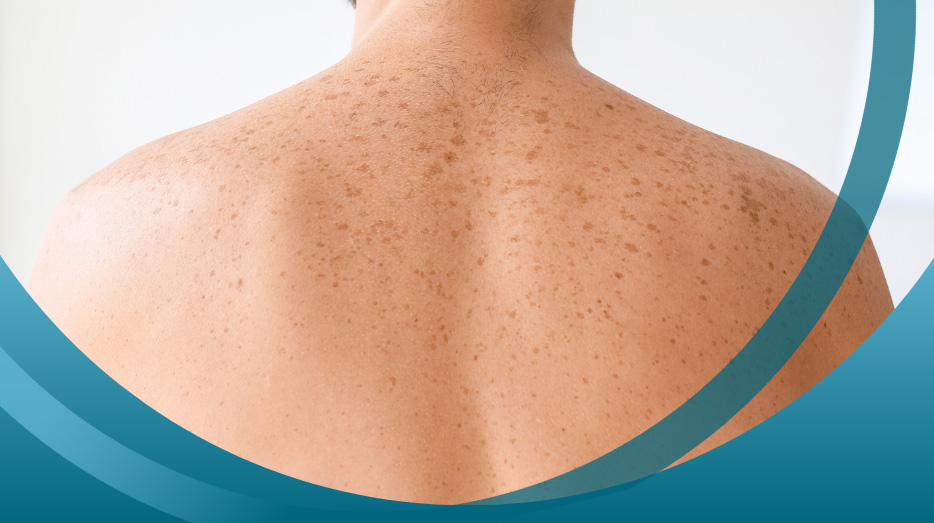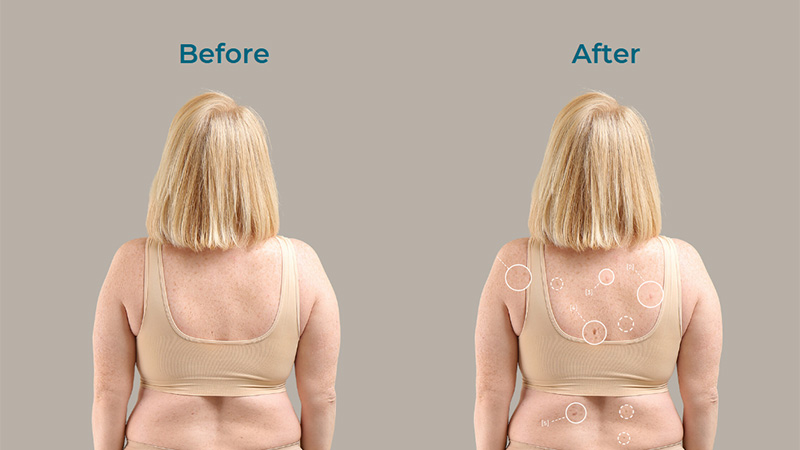Skin cancer is one of the most prevalent cancers in Australia, with over two-thirds of Australians likely to develop it at some point in life.
At Skintel, we’re big believers in seeing skin differently. That’s why we use advanced technologies like a total body scan to create a mole map (compared to the traditional mole map based on a series of photographs).
What is mole mapping?
Mole mapping – or, in our case, a total body map – is a non-invasive procedure that uses state-of-the-art technology to create a head-to-toe map of every mole on your body.
You disrobe briefly while the body map scanner captures every visible surface of your body. That takes less than 2 minutes!
While you get dressed, sophisticated software creates your mole map. Every mole (including those not visible to the naked eye) is pulled off your scan and tagged to create a unique map. Artificial intelligence then identifies and highlights any suspicious moles that require further investigation using evidence-based criteria such as shape, size, colour or asymmetry.
How does a mole map aid skin cancer diagnosis?
Your mole map provides a baseline from which we can track changes in every single mole over time. Subsequent total body scans can be compared with your initial one to show whether a certain mole has grown or changed shape.
This proactive approach is particularly beneficial for high-risk individuals as it helps detect subtle changes that might go unnoticed during self-examinations.
If all your moles are found to be normal, you benefit from peace of mind.
If we do find some dubious moles, we progress to a dermoscopy where we examine those moles in greater detail. If any are still concerning then, at Skintel, we may recommend an optical biopsy using a laser microscope that enables us to immediately diagnose (or rule out) skin cancer. This non-invasive biopsy can be particularly beneficial for moles on the face, where you may not wish to run the risk of scarring associated with traditional biopsy.
Who is at high risk for skin cancer?
While anyone can develop skin cancer, certain factors increase your risk, making mole mapping a crucial preventive measure. Those risk factors include:
- Having many moles: People with more than 50 moles are at a higher risk of melanoma.
- Increased sun exposure: If you work outdoors or enjoy outdoor pursuits, you’re exposed to more UV rays, which can increase the risk of skin cancer. The same applies to regular users of tanning beds.
- Fair skin: Those with light skin, freckles, or who burn easily have less natural protection against UV damage.
- Family history of melanoma: A genetic predisposition to melanoma increases risk significantly.
- Previous skin cancer diagnosis: If you’ve had melanoma or non-melanoma skin cancer, regular monitoring is critical to prevent recurrence.
If you belong to any of these categories, regular mole checks and body scans can increase your chances of detecting any precancerous or cancerous changes to enable prompt action.
Signs to watch for
Skin cancer often presents with subtle changes in your moles. Seek medical attention if you notice:
- An itchy mole: Persistent itching can signal irritation or changes within the mole.
- Changes in shape, size, or colour: Moles that grow unevenly or darken may require further examination.
- New moles: Any new mole that appears after age 30 should be monitored closely.
- Bleeding or crusting: This may indicate malignancy and warrants immediate medical review.
The ABCDE rule is an excellent guide for identifying concerning changes, encouraging you to check your moles for:
- Asymmetry
- Border irregularity
- Colour variation
- Diameter >6mm
- Evolution (change).
How can we help?
Seeing skin differently delivers important insights that can help protect your health, especially if you’re at high risk of skin cancer.
If that’s you – or if you’re concerned about a suspicious mole – please book a body map as soon as you can. We’d love to help you take good care of your skin.
Disclaimer
All information is general and not intended as a substitute for professional advice.
References
- Cancer Council NSW, About skin cancer, https://www.cancercouncil.com.au/skin-cancer/about-skin-cancer/, [Accessed 5 December 2024]
- SunSmart, Skin cancer, https://www.sunsmart.com.au/skin-cancer#risk-factor, [Accessed 5 December 2024]
- AIM at Melanoma Foundation, Moles or melanoma, https://www.aimatmelanoma.org/melanoma-101/understanding-melanoma/moles-and-other-lesions/, [Accessed 5 December 2024]
- Healthdirect, Should I be checked for skin cancer?, https://www.healthdirect.gov.au/should-I-be-checked-for-skin-cancer, [Accessed 5 December 2024]
- Cancer Council, Check for signs of skin cancer, https://www.cancer.org.au/cancer-information/causes-and-prevention/sun-safety/check-for-signs-of-skin-cancer, [Accessed 5 December 2024]





